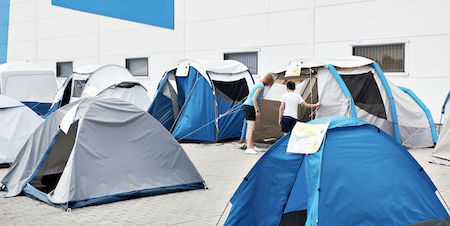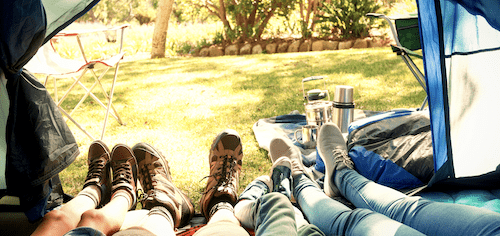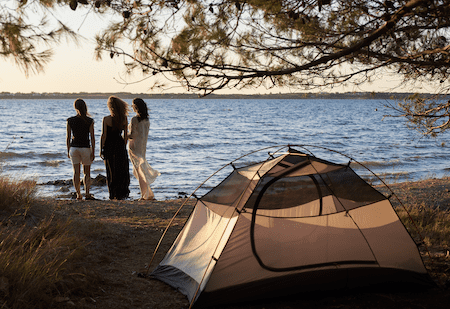Before you start packing your bag, there are a few essential items that are a must-have for your adventure. And one of the most important things to keep in mind while setting out to camp is your tent and its size.
If you’re new to camping, you’re probably wondering, what size tent do I need for camping?
We have compiled a detailed guide on choosing the perfect tent size to answer this question.
Keep reading our article to figure out the right tent size for your camping trip.
How To Choose Your Ideal Tent Size
In today’s market, you can find tents of all shapes and sizes. The options range from huge tunnel tents to the tiniest pup tents. When buying tents, you will find a lot of information on the tentmaker’s site or on the packaging.
However, the capacities listed in product descriptions or specifications should not be used to determine whether or not a tent is suitable for a certain number of sleepers. Instead, before purchasing a tent, we should consider a few crucial things.
Your requirements will decide the best tent size for you. You’ll need a different tent if you’re going camping with a team or alone than if you’re accompanying a family with children.
Many factors must be considered while deciding on a tent size for camping, such as the projected period of use, desired comfort level, weather conditions, etc.
It might seem a bit overwhelming, but don’t worry, as we’ll be going through all the necessary measurements that you should keep in mind before buying the right tent for camping.
#1. Tent Capacity
It’s arguably the most significant factor. Tents are sized according to the number of people they can accommodate, not including their gear.
The producers of all tents categorize them as 4-person tents, 2-person tents, 1-person tents, etc. They indicate how many people can sleep in a tent, but you should not blindly rely on them.
The capacity number will give you an approximation of how many people can fit into a tent. However, most customers believe that capacity figures overstate the actual size of the tent.
A typical rule of thumb is to deduct two people from each tent’s capacity rating, to get the correct number for your tent size. Typically, this is how the sizing guides differ from customer experiences.
With items placed in the vestibule, 1-person tents are typically comfortable for 1 person. 2 person tents are a luxury for 1 person with an inside gear storage room but are a tight fit for 2 people with vestibule stuff. A compact 2-person tent is easy to put up, move, and less expensive than larger tents.
Three-person tents are spacious for two people and have internal gear storage. Two broad sleeping mats will fit within. These are suitable for two people plus a child or dog, but three grown adults will find them uncomfortable.
For 2-3 people, 4-person tents are luxurious, with internal gear storage. Although space is limited, three persons plus a kid or pet can be accommodated. However, it may be a very tight squeeze for four regular individuals.
If you’re driving to the campground, 5-person camping tents are ideal. The benefits of 5-person tents include increased internal storage, comfort, and space. However, these tents are not quite lightweight.
Four persons plus belongings fit comfortably in a six-person tent. However, these are usually too small for 5 or 6 campers.
For 5 people plus gear, 8-person tents are comfortable. These are also suitable for 6 people if some of them are youngsters or pets. Tents for ten people may accommodate six people plus gear.
However, these are insufficient for groups of 8 or more. Even if we halt at this size, keep in mind that larger tents are available. You may even get 12- or 16-person tents if necessary.
Here’s a quick chart for your convenience:
| Mentioned Capacity | Floor Area (Appx.) | Day Camping Capacity | Sleeping Capacity |
|---|---|---|---|
| 4 Person | 70 sqft | 3 Adults | 2 Adults |
| 6 Person | 100 sqft | 4 Adults | 3 Adults |
| 8 Person | 130 sqft | 6 Adults | 4 Adults |
| 10 Person | 160 sqft | 8 Adults | 5 Adults |
| 12 Person | 170 sqft | 9 Adults | 6 Adults |
| 14 Person | 190 sqft | 10 Adults | 8 Adults |
| 16 Person | 220 sqft | 12 Adults | 10 Adults |
| 20 Person | 300 sqft | 17 Adults | 14 Adults |
Building up a tent of this size would almost certainly require assistance, but it can be a pleasant family project to engage with. Using a little experience, you’ll be able to set up your tent in time.
And if you don’t want to take that hassle, you can always opt for instant tents to save you time and energy.
#2. Sleeping Area
Another critical aspect of a tent is the sleeping space. Tentmakers are prone to exaggerating their tents’ capacity based on overly optimistic estimates of how much floor space the adult human need for a pleasant night’s sleep.
With online listings, you’ll find an image of the tent’s specifications. When purchasing a tent, check to see if it will be broad enough to fit all of the campers.
The best policy is to get these out and measure them yourself to avoid any wrong measurement.
For a pleasant night’s sleep beneath the canvas, a typical adult sleeper needs around 14 square feet. You should be able to locate the dimensions in the tent’s specs.
Also, take into account the size and age of the campers. A packed tent can cause difficulties, which detract from the whole experience.
Tall folks will require more room to stretch out throughout the night, so make sure the sleeping chamber is long enough.
Two toddlers can easily accommodate in the same area as one older child but keep in mind that they will grow, so plan if you want your tent to last a few years.
If you’re camping with teens, they’ll require as much space as an adult, and presumably, they’ll sleep in a separate section of the tent from you, giving you and them some much-needed privacy.
#3. Configurations
Regardless of the size, camping tents may feature add-ons like vestibules, gear lofts, rainfly, roofs, and storage pockets.
The size of your tent will need to shelter all the necessary equipment you are carrying for your trip. So keeping the configurations of your tent in mind is essential for picking the right size.
#4. Vestibules
Vestibules are covered sections on the side of your tent’s front that store any items you don’t want to bring inside with you, such as boots, damp or dirty clothes, camping grills, cooking appliances, backpack, and so on.
The size of the vestibule you’ll need is determined by how many camping kits you plan to bring. However, the wider the vestibule, the more space you may free up within the tent by storing your things there.
A bigger vestibule would make a living at camp a lot more pleasant and convenient, specifically if you’re camping in the rain with your kids or hauling a kit for gear-intensive sports like rock climbing.
A smaller vestibule will suffice if you have fewer items to store.
#5. Rainfly And Roofs
The rainfly can sometimes be roof-only or cover the whole roof. The full-coverage rainfly provides total weather protection as well as additional warmth. You might wish to investigate a double-wall tent for the same purpose.
The inner wall allows for more airflow, while the outside wall protects you from the elements. Furthermore, double-wall tents are excellent at keeping moisture out of the sleeping area.
Peak height is a word commonly used by campers when discussing roofs. The tent’s height at its tallest point is referred to as peak height, sometimes known as center height.
Tents with a higher peak height give greater headroom, making it easier to move around and, more crucially, prevent cabin fever if you stay longer than a night or two in the wilderness.
Suppose you plan to use your tent primarily for car camping vacations.
You can afford a tent with a higher peak height – partly because you won’t have to carry it as far before pitching it and since developed campgrounds are typically less vulnerable to the wind than rural campsites.
The height of the people at your camping party will determine how tall you should go.
If you or one of your camping companions is over 6 feet tall, a tent with a peak height of 72 inches or more is your best choice; if your camping companions are shorter or want to lean over to dodge the roof canopy, peak heights of 60-70 inches should do.
Finally, you must examine the floor carefully. For further ground protection, some tents have a footprint or tarp.
These improvements can be made inside or outside the tent to increase its overall stability and comfort.
#6. Comfort
Comfort is a significant consideration when going camping. Especially if you intend to stay for more than one night, you should think about your comfort when choosing your tent size.
When traveling in places where frequent storms or an abundance of mosquitos are predicted, a somewhat larger, a roomier tent is typically preferable.
When the weather isn’t cooperating, you’ll spend a lot more time in your tent, and a narrow tent can quickly seem stifling.
The weight savings of bringing a thin and light hiking tent may be worth losing a bit of additional room for long tours with a lot of elevation gain.
It’s more effective on tours where the environment is expected to be nice, and you’ll be sleeping in your tent horizontally.
#7. Usability
You need to consider what you intend to do with your tent and how long you intend to use it.
On longer excursions, make sure there is enough room for everyone to relax comfortably. Don’t forget about storage space for your luggage and equipment.
A lighter tent that is simple to set up and takes up less room in your car can be a better choice if you plan to use your tent mostly for short weekend getaways or touring trips when you go from place to place.
If the weather is terrible, you’ll appreciate the extra room because you’ll enjoy more time indoors. The same is valid for excursions taken earlier or later in the year when the sun sets earlier.
Finally, if your vacations include hiking, backpacking, biking, kayaking, or other adventure activities, you’ll need a more advanced tent.
Some campers take two or more tents to accommodate various forms of camping, such as a large type for the major summer vacation and a smaller version for weekend getaways.
Another alternative is a compact tent for short journeys and an overhang or extension for longer vacations. If carrying the tents is not an issue for you, you can opt for multiple tents.
Things To Consider Other Than The Tent Size
When buying a hiking or camping tent, size is one of the most crucial factors. You’ll want a big enough shelter to be comfortable, but you’ll also want to consider weight, bulk, convenience, and cost.
After determining the size, consider the materials and camping season to get the best camping experience.
The answer isn’t black-and-white, and the best tent for your adventures will ultimately depend on several factors.
It includes the season you’re camping in, how many kits you’re bringing, whether you plan on backcountry or front-country camping, etc.
The number of campers, your relationship with the campers, and the length of your trip also matter a lot. These will have a significant impact on your camping experience.
In the end, the average tent size is just one component of the jigsaw. So, before choosing your ideal tent, be sure you check all of the boxes.
Conclusion
Choosing the right tent size is vital as it can destroy or enhance your outdoor experience. After reading this article, we hope you will have the answer to your query- what size tent do I need for camping.
There is no better time to explore the great outdoors than now. We hope you find this helpful information and that your camping trip provides you with more variety, comfort, and pleasure.
So, pack your bags and set off for some serenity in Mother Nature.



